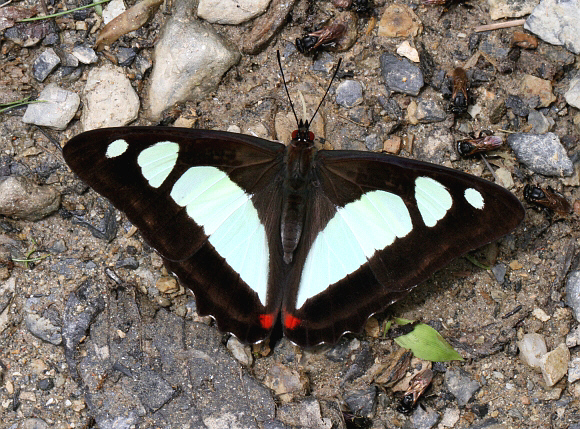
Introduction
The genus Pyrrhogyra includes 6 known species, all marked on the underside with large white areas enclosed within rings that are formed from narrow red lines. An unusual and notable feature is that the butterflies also have red eyes.
All Pyrrhogyra species are very similar in appearance. They can be distinguished from one another by carefully examining the markings around the underside hindwing margins and by comparing the size and shape of the greenish-white areas on the dark brown uppersides.
The butterflies are exclusively neotropical, some species being found as far north as Mexico, and others as far south as Bolivia and Paraguay, but the state of Amazonas in Brazil probably has the highest diversity of species.
Pyrrhogyra edocla is the most widespread and common species, found from Mexico to Bolivia.
Habitats
This butterfly can be found in most forest habitats, including deciduous areas, at elevations from about 500-1800 metres.

Lifecycle
The eggs are pale yellow and shaped like flattened cones. They are laid singly on young leaves of the foodplants. The caterpillar is pale green, densely covered on the back and sides with branched black spikes. Its head is deep pink, and bears a pair of long whorled spikes. It feeds diurnally on the foliage of Paullinia or Serjania plants (Sapindaceae). The chrysalis is green with brown wing-cases and is attached by the cremaster to the upper surface of a leaf, projecting laterally.
Adult behaviour
Males are usually encountered singly or sometimes in twos or threes when imbibing moisture from urine-soaked sand, damp rocks, or wet foliage. These feeding sites are usually within the forest, at light gaps or on wide trails, although the butterflies will also visit open sandbanks.
Females are seen less frequently, usually when basking on low foliage between egg-laying sessions, or when visiting flowers.
If disturbed the butterflies fly off rapidly and hide upside-down beneath leaves on bushes or young saplings, usually no more than a meter from the ground. They also go to roost in similar situations overnight or in dull or wet weather.
